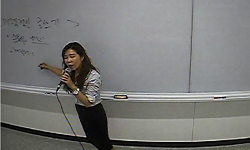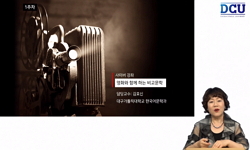이 글에서는 2000년 이후 제작된 영상물을 정리한 후, 그 ‘기획의도’를 분석하여 유형화하고, 구체적으로 몇몇 영상물을 분석하여 시대상 표현이나 현대적 의미까지 분석하여 평가해 보았...
http://chineseinput.net/에서 pinyin(병음)방식으로 중국어를 변환할 수 있습니다.
변환된 중국어를 복사하여 사용하시면 됩니다.
- 中文 을 입력하시려면 zhongwen을 입력하시고 space를누르시면됩니다.
- 北京 을 입력하시려면 beijing을 입력하시고 space를 누르시면 됩니다.
부가정보
국문 초록 (Abstract)
2000년 이후 제작된 19개 영상물을 정리해 보면, 대상시기는 7세기, 대상국가는 고구려, 주인공은 왕실 관련 인물, 방영(개봉)시기는 2005~2009년, 장르는 퓨전이 가장 많았다. 특히 2005~2009년에 동북공정에 대한 대응 차원에서 고구려·발해 관련 드라마가 집중적으로 제작되었다가, 그 이후에는 대상국가나 주인공이 다양화되는 경향에 있었다.
다음으로 기획의도를 분석해 보면, ①민족주의(국수주의)에 바탕을 두고 제국을 꿈꾸는 것이 8개, ②개인이나 국가를 재평가하려는 것 7개, ③새로운 소재와 내용을 보여주려는 것이 4개였다.
복수의 영상물에서 공통적으로 나타나는 왜곡된 시대상으로는 ①‘황제’(‘제국’) 호칭과 연호, ②중국과의 대결 중심으로 표현된 대외정책, ③광활한 대륙의 지배를 들 수 있었다. 영상물에서 잘 표현된 시대상의 사례로는 ①김유신에 대한 재해석, ②무왕의 탄생비밀에 대한 해석, ③정사암회의에 대한 묘사, ④고대사회의 신비주의적 정치에 대한 해석 등이 있었다.
영상물에서 맥락 없이 과도하게 표현된 현대적 의미의 사례로는 ①단일민족적 묘사, ②멜로드라마 구도를 차용하여 내용상 사적 영역이 지배하는 경향을 낳았다는 점을 들 수 있었다. 영상물에서 잘 표현된 현대적 의미의 사례로는 새로운 인물의 부각이나 인물에 대한 재해석을 들 수 있었고, 현실 사회에서 벌어진 정치적 사건을 고대적으로 풍자한 개별 작품의 사례도 있었다.
이 글에서는 2000년 이후 제작된 영상물을 정리한 후, 그 ‘기획의도’를 분석하여 유형화하고, 구체적으로 몇몇 영상물을 분석하여 시대상 표현이나 현대적 의미까지 분석하여 평가해 보았다. 그 내용은 다음과 같다.
2000년 이후 제작된 19개 영상물을 정리해 보면, 대상시기는 7세기, 대상국가는 고구려, 주인공은 왕실 관련 인물, 방영(개봉)시기는 2005~2009년, 장르는 퓨전이 가장 많았다. 특히 2005~2009년에 동북공정에 대한 대응 차원에서 고구려·발해 관련 드라마가 집중적으로 제작되었다가, 그 이후에는 대상국가나 주인공이 다양화되는 경향에 있었다.
다음으로 기획의도를 분석해 보면, ①민족주의(국수주의)에 바탕을 두고 제국을 꿈꾸는 것이 8개, ②개인이나 국가를 재평가하려는 것 7개, ③새로운 소재와 내용을 보여주려는 것이 4개였다.
복수의 영상물에서 공통적으로 나타나는 왜곡된 시대상으로는 ①‘황제’(‘제국’) 호칭과 연호, ②중국과의 대결 중심으로 표현된 대외정책, ③광활한 대륙의 지배를 들 수 있었다. 영상물에서 잘 표현된 시대상의 사례로는 ①김유신에 대한 재해석, ②무왕의 탄생비밀에 대한 해석, ③정사암회의에 대한 묘사, ④고대사회의 신비주의적 정치에 대한 해석 등이 있었다.
영상물에서 맥락 없이 과도하게 표현된 현대적 의미의 사례로는 ①단일민족적 묘사, ②멜로드라마 구도를 차용하여 내용상 사적 영역이 지배하는 경향을 낳았다는 점을 들 수 있었다. 영상물에서 잘 표현된 현대적 의미의 사례로는 새로운 인물의 부각이나 인물에 대한 재해석을 들 수 있었고, 현실 사회에서 벌어진 정치적 사건을 고대적으로 풍자한 개별 작품의 사례도 있었다.
다국어 초록 (Multilingual Abstract)
Among 19 videos produced after 2000, we can find that most of them described royal family, Goguryeo and the 7th century with the genre of fusion historical drama. Most of those videos was televised or released between the year of 2005 and 2009. Notably, the dramas regarding Goguryeo and Balhae were produced intensively to cope with China’s Northeast Project from the year of 2005 to 2009. Then, after that, the countries or protagonists described in dramas or movies have become varied.
The purposes of 19 dramas and movies can be analyzed as follows. Motives of 8 videos’ were dreaming the empire based on the nationalism or chauvinism. 7 videos intended to revaluate certain individuals or ancient countries. 4 videos tried to show new materials and stories.
We can point out that common distorted reflection of the historical era from 19 videos such as using the title of an emperor or empire and era name, foreign policy described mainly as the conflict with Chinese dynasty, and the rule over the vast continent. A number of the examples from the videos were well depicted: reinterpretation of Kim Yushin(金庾信), new interpretation of the secret of King Mu(武王)’s birth, depiction of the council of Jeongsaam(政事巖) and interpretation of the mystical politics in ancient society.
A few contemporary meanings without the context were inserted excessively in the videos. They were the description of a nation-state and melodramatic story controlled by private space. Other examples well described in the modern context were emergence or reinterpretation of new characters. There was also an individual work satirizing current political issue with the ancient mode.
This article researched the videos on ancient Korean history since 2000 and then classified them by analyzing their purposes, and reviewed several videos of them by analyzing historical representation or contemporary meaning. Among 19 videos produc...
This article researched the videos on ancient Korean history since 2000 and then classified them by analyzing their purposes, and reviewed several videos of them by analyzing historical representation or contemporary meaning.
Among 19 videos produced after 2000, we can find that most of them described royal family, Goguryeo and the 7th century with the genre of fusion historical drama. Most of those videos was televised or released between the year of 2005 and 2009. Notably, the dramas regarding Goguryeo and Balhae were produced intensively to cope with China’s Northeast Project from the year of 2005 to 2009. Then, after that, the countries or protagonists described in dramas or movies have become varied.
The purposes of 19 dramas and movies can be analyzed as follows. Motives of 8 videos’ were dreaming the empire based on the nationalism or chauvinism. 7 videos intended to revaluate certain individuals or ancient countries. 4 videos tried to show new materials and stories.
We can point out that common distorted reflection of the historical era from 19 videos such as using the title of an emperor or empire and era name, foreign policy described mainly as the conflict with Chinese dynasty, and the rule over the vast continent. A number of the examples from the videos were well depicted: reinterpretation of Kim Yushin(金庾信), new interpretation of the secret of King Mu(武王)’s birth, depiction of the council of Jeongsaam(政事巖) and interpretation of the mystical politics in ancient society.
A few contemporary meanings without the context were inserted excessively in the videos. They were the description of a nation-state and melodramatic story controlled by private space. Other examples well described in the modern context were emergence or reinterpretation of new characters. There was also an individual work satirizing current political issue with the ancient mode.
목차 (Table of Contents)
- 국문초록
- I. 머리말
- II. 2000년 이후의 영상물 현황
- III. 각 영상물의 기획의도와 경향성
- IV. 영상물에서 표현된 시대상과 왜곡
- 국문초록
- I. 머리말
- II. 2000년 이후의 영상물 현황
- III. 각 영상물의 기획의도와 경향성
- IV. 영상물에서 표현된 시대상과 왜곡
- V. 영상물에서 표현된 현대적 의미와 평가
- VI. 맺음말
- 참고문헌
- Abstract
참고문헌 (Reference)
1 이길성, "해방 이후 뉴스-문화영화 제작사 연구 ― 민간 영화사를 중심으로 ―" 수선사학회 (53) : 239-263, 2015
2 김현숙, "역사적 관점에서 본 ‘태왕사신기’" 호서사학회 (49) : 1-33, 2008
3 권덕영, "역사와 역사소설 그리고 사극 ― 장보고와 ‘해신’을 중심으로 ―" 한국역사연구회 (60) : 141-172, 2006
4 한규철, "역사와 발해 드라마 ‘대조영’" 고구려발해학회 28 : 73-94, 2007
5 서길수, "역사와 고구려 드라마 ‘주몽’" 고구려발해학회 28 : 9-48, 2007
6 김용만, "역사와 고구려 드라마 ‘연개소문’" 고구려발해학회 28 : 49-72, 2007
7 李基東, "역사소설·史劇의 功과 過" 20 : 1997
8 주창윤, "역사드라마의 역사서술방식과 장르형성" 한국언론학회 48 (48): 166-188, 2004
9 정동준, "드라마·영화에 나타난 고대사" 2016
10 임기환, "대중교육과 대중매체에 나타난 광개토왕대 고구려 역사상" 한국고대사학회 (67) : 269-298, 2012
1 이길성, "해방 이후 뉴스-문화영화 제작사 연구 ― 민간 영화사를 중심으로 ―" 수선사학회 (53) : 239-263, 2015
2 김현숙, "역사적 관점에서 본 ‘태왕사신기’" 호서사학회 (49) : 1-33, 2008
3 권덕영, "역사와 역사소설 그리고 사극 ― 장보고와 ‘해신’을 중심으로 ―" 한국역사연구회 (60) : 141-172, 2006
4 한규철, "역사와 발해 드라마 ‘대조영’" 고구려발해학회 28 : 73-94, 2007
5 서길수, "역사와 고구려 드라마 ‘주몽’" 고구려발해학회 28 : 9-48, 2007
6 김용만, "역사와 고구려 드라마 ‘연개소문’" 고구려발해학회 28 : 49-72, 2007
7 李基東, "역사소설·史劇의 功과 過" 20 : 1997
8 주창윤, "역사드라마의 역사서술방식과 장르형성" 한국언론학회 48 (48): 166-188, 2004
9 정동준, "드라마·영화에 나타난 고대사" 2016
10 임기환, "대중교육과 대중매체에 나타난 광개토왕대 고구려 역사상" 한국고대사학회 (67) : 269-298, 2012
11 박선영, "국가의 프레임으로 구획된 베트남전쟁 - 국립영화제작소와 국군영화제작소의 베트남전쟁 영화를 중심으로 -" 수선사학회 (53) : 57-91, 2015
12 주창윤, "고구려 역사 드라마의 역사서술과 재현" 고구려발해학회 28 : 95-110, 2007
13 여호규, "고구려 드라마 열풍의 허(虛)와 실(實)" 41 : 2007
14 홍성화, "歷史小說, 歷史드라마에 나타난 古代史像 고찰" 5 : 2013
동일학술지(권/호) 다른 논문
-
- 한국고대사학회
- 최광식(Choe, Kwang-Shik)
- 2016
- KCI등재
-
- 한국고대사학회
- 주성지(Joo, Sung-jee)
- 2016
- KCI등재
-
- 한국고대사학회
- 차순철(CHA, Soon-Chul)
- 2016
- KCI등재
-
- 한국고대사학회
- 정재윤(Chung, Jae-Yun)
- 2016
- KCI등재
분석정보
인용정보 인용지수 설명보기
학술지 이력
| 연월일 | 이력구분 | 이력상세 | 등재구분 |
|---|---|---|---|
| 2026 | 평가예정 | 재인증평가 신청대상 (재인증) | |
| 2020-01-01 | 평가 | 등재학술지 유지 (재인증) |  |
| 2017-01-01 | 평가 | 등재학술지 유지 (계속평가) |  |
| 2013-01-01 | 평가 | 등재학술지 유지 (등재유지) |  |
| 2010-01-01 | 평가 | 등재학술지 유지 (등재유지) |  |
| 2008-07-07 | 학회명변경 | 영문명 : The Korean Ancient Historical Association -> The Society for Ancient Korean History |  |
| 2008-01-01 | 평가 | 등재학술지 유지 (등재유지) |  |
| 2005-01-01 | 평가 | 등재학술지 선정 (등재후보2차) |  |
| 2004-01-01 | 평가 | 등재후보 1차 PASS (등재후보1차) |  |
| 2002-01-01 | 평가 | 등재후보학술지 선정 (신규평가) |  |
학술지 인용정보
| 기준연도 | WOS-KCI 통합IF(2년) | KCIF(2년) | KCIF(3년) |
|---|---|---|---|
| 2016 | 1.69 | 1.69 | 1.84 |
| KCIF(4년) | KCIF(5년) | 중심성지수(3년) | 즉시성지수 |
| 1.64 | 1.57 | 3.463 | 0.17 |




 DBpia
DBpia







